Top Video Hosting Platforms for Online Courses in 2025

Choosing where to host your course videos is a bigger decision than you might think. It is about finding a platform that protects your content, delivers a smooth, buffer-free experience for your students, and gives you the analytics you need to improve your courses. Get it wrong, and you risk piracy, poor student engagement, and a lot of technical headaches. Get it right, and you create a professional, secure, and seamless learning environment that lets your teaching shine.
This guide is designed to cut through the noise. I’ve spent countless hours testing and comparing the top video hosting platforms for online courses to help you make the right choice for your specific needs.
Before you dive into hosting, you first need a solid foundation. If you’re still refining your process, this guide on creating engaging tutorial videos is an excellent resource to ensure your content is top-notch from the start.
In this list, we’ll break down everything from specialized video hosts like Vimeo and Wistia to all-in-one course platforms like Kajabi and Thinkific. Each review covers the essential features, pricing structures, and the honest pros and cons based on real-world use. You’ll find direct links and screenshots for every platform, making it easy to see exactly what they offer. My goal is to give you a clear, practical comparison so you can confidently pick the perfect home for your videos and get back to what you do best: teaching.
1. Vimeo
Vimeo has long been a go-to choice for professionals, and it’s one of the best video hosting platforms for online courses if you prioritize a clean, ad-free experience. The platform is built around providing creators with complete control over their content, from how the player looks to who can watch it. I’ve always appreciated how Vimeo lets you customize the video player to match your course website’s branding, creating a seamless and professional look for your students.
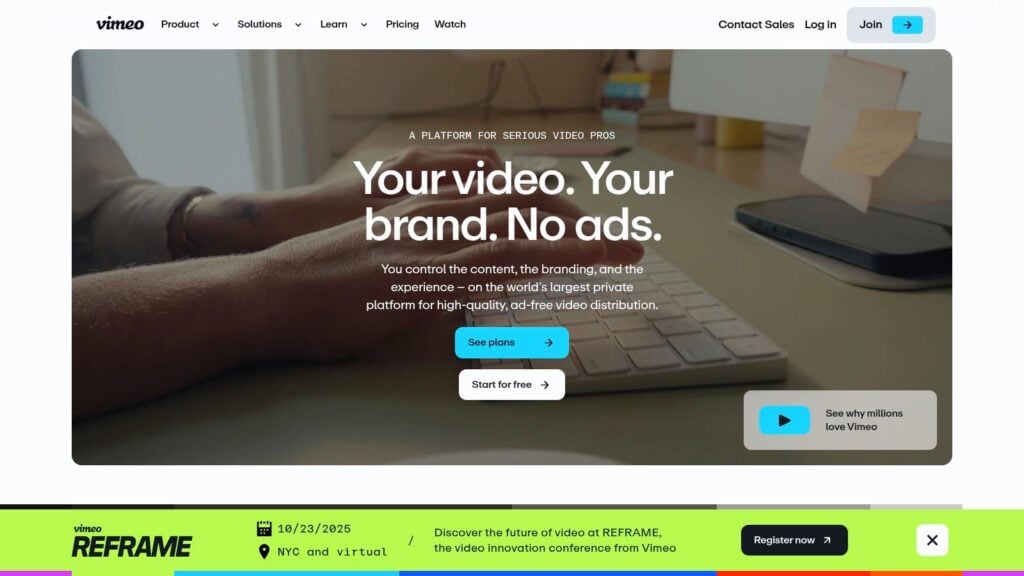
Unlike YouTube, Vimeo ensures your audience won’t be distracted by ads or competitor video recommendations. This focus on the viewer experience is crucial for educational content. The privacy controls are robust, allowing you to password-protect videos, hide them from the Vimeo site, or restrict embedding to specific domains, which is perfect for protecting your premium course content.
Key Features & Pricing
Vimeo’s plans start with the Starter tier at $12 per seat/month (billed annually), offering player customization and password protection. For features like virtual events and marketing integrations, you’ll need the Standard ($20/seat/month) or Advanced ($65/seat/month) plans. They also offer Enterprise and OTT (Over-The-Top) solutions for creators who want to build their own Netflix-style subscription service.
Pros:
- Completely ad-free, professional viewing experience.
- Powerful player customization and branding controls.
- Extensive privacy settings to secure your course videos.
- Mature platform with strong integration support for course platforms.
Cons:
- The free plan is very limited for serious course creators.
- Pricing and features can change, sometimes requiring you to dig into the details.
- Recent plan updates have shifted focus, so it’s good to check current terms.
Vimeo is an excellent fit if your primary goal is a polished, branded video experience integrated directly into your existing course website or LMS.
Website: https://vimeo.com/
2. Wistia
Wistia is a fantastic choice if you view your course videos as a core part of your marketing and sales funnel. It’s built for businesses, so it comes packed with tools designed to not just host content, but to analyze its performance and capture leads. I’ve found its analytics to be incredibly detailed, showing you exactly where individual students drop off, which can be invaluable for improving your course material. It’s one of the best video hosting platforms for online courses when engagement metrics are a top priority.
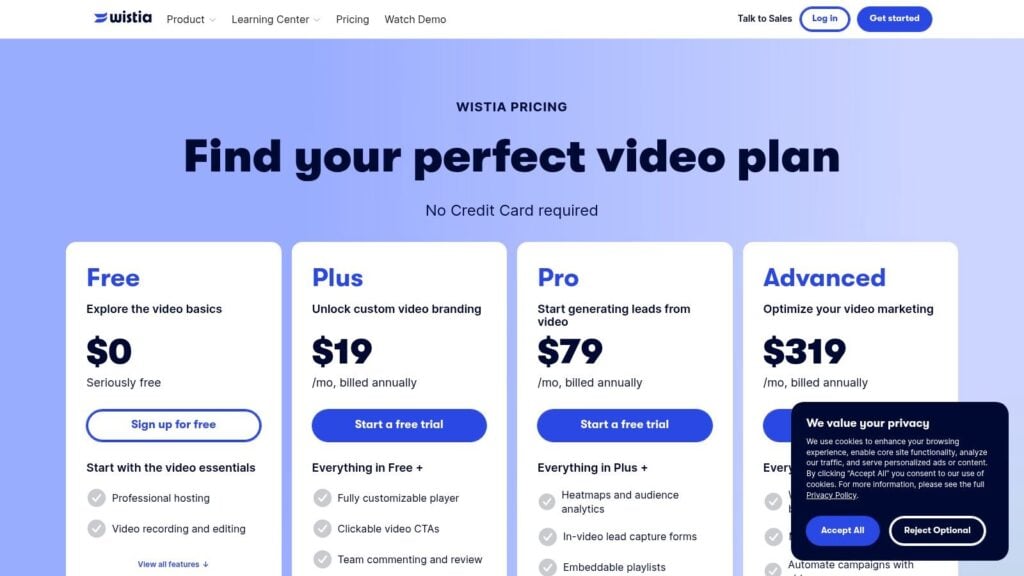
The platform gives you a clean, ad-free player that you can customize to match your brand. A standout feature is the ability to add “Turnstiles” (email capture forms) directly within your videos, perfect for lead generation or gating specific lessons. It also offers features like interactive video chapters and detailed SEO settings to help your content get discovered.
Key Features & Pricing
Wistia offers a generous Free plan that includes a branded player and standard analytics for up to 10 videos. For more advanced features, the Plus plan starts at $24/month (billed annually) and includes player customization and lead capture forms. The Pro plan at $99/month adds video heatmaps and marketing integrations. A key detail is that plans come with a set number of included media files, and you’ll pay a small per-asset fee for anything beyond that limit.
Pros:
- Excellent analytics and engagement tools to understand student behavior.
- Clean, brand-controlled, and completely ad-free video embeds.
- Built-in lead capture and marketing automation integrations.
- Simple tiered pricing with a useful free plan to get started.
Cons:
- Per-asset fees for media beyond the plan’s limit can add up.
- It’s a hosting platform, not an all-in-one LMS, so you’ll need to pair it with other tools.
Wistia is ideal for course creators who are serious about marketing and want deep insights into how their video content performs.
Website: https://wistia.com/pricing
3. SproutVideo
SproutVideo is a fantastic choice if security and granular access control are at the top of your list. It’s one of the more robust video hosting platforms for online courses, built specifically for businesses that need to protect premium content. I’ve been impressed with its powerful security features, like viewer logins and IP address restrictions, which give you total confidence that only paying students can access your lessons.
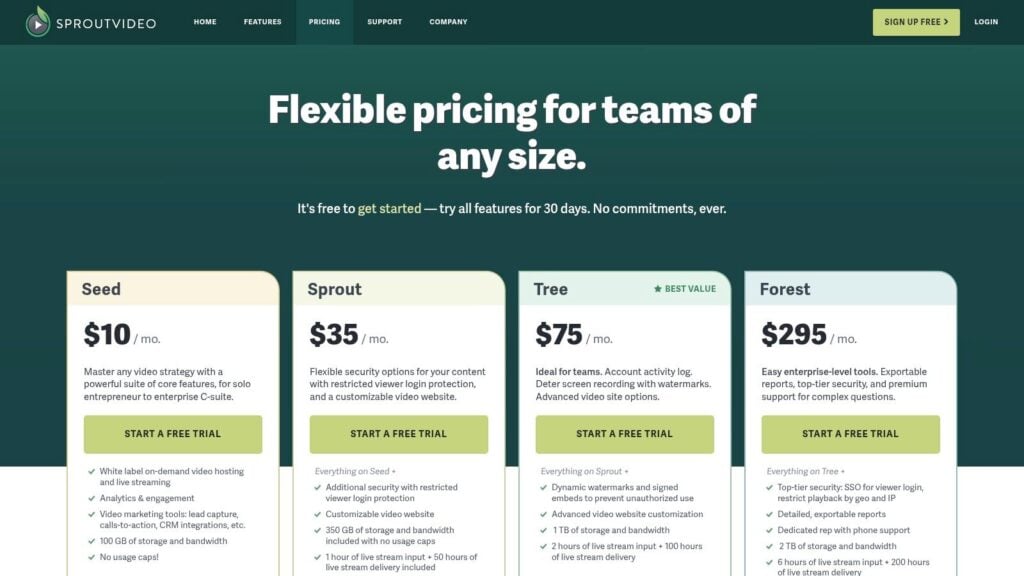
The platform is designed to be completely white-label, allowing you to create a branded video experience that feels like a natural part of your course website. Beyond just hosting, SproutVideo includes useful marketing tools like lead capture forms and in-player calls-to-action, helping you convert viewers into students. It also lets you build fully hosted video landing pages or entire video websites, which is a great bonus.
Key Features & Pricing
SproutVideo’s plans are known for their transparency, bundling storage and bandwidth. The Seed plan starts at $10/month, but most course creators will need the Sprout ($35/month) or Tree ($75/month) plans for features like viewer logins and security presets. Higher tiers like Forrest ($295/month) add SSO and advanced integrations. Be mindful of overage fees if you exceed your plan’s limits for storage, bandwidth, or live stream minutes.
Pros:
- Excellent security features including viewer logins and geo-restrictions.
- Transparent pricing with generous included storage and bandwidth.
- Fully white-label player and hosted video websites.
- Helpful built-in marketing tools like CTAs and lead capture.
Cons:
- Overage fees can apply if you exceed plan limits.
- It isn’t a full Learning Management System (LMS), so you need a separate tool for payments.
- The interface can feel a bit more technical than some competitors.
SproutVideo is ideal for course creators who need top-tier security to protect their premium video content and want a highly customizable, branded solution.
Website: https://sproutvideo.com/pricing
4. Dacast
Dacast is a professional-grade platform that positions itself as a powerful solution for both video-on-demand (VOD) and live streaming, making it one of the more versatile video hosting platforms for online courses. It’s geared toward creators who need robust monetization and security features built right in. I find its combination of paywall integration and enterprise-level security like DRM particularly compelling for those selling high-ticket courses or running live, paid workshops.

Unlike simpler hosting services, Dacast is built for broadcasting and monetization from the ground up. This means you can easily set up pay-per-view access for a specific live training or create a subscription video library (SVOD) for your entire course catalog. Its multi-CDN infrastructure, including options for delivery in China, also ensures reliable streaming for a global student base, which is a significant advantage for creators with an international audience.
Key Features & Pricing
Dacast’s pricing is based on bandwidth and storage, starting with the Starter plan at $39/month (billed annually), which includes 2.4 TB of bandwidth per year and 500 GB of storage. The popular Event plan at $63/month offers more bandwidth and is designed for one-off events. For advanced features like DRM, you’ll need the Scale plan ($165/month) or a custom plan.
Pros:
- Built-in monetization tools like paywalls (SVOD, TVOD, AVOD).
- Strong security options including DRM and AES encryption on higher plans.
- Event-specific plan is great for live course launches or workshops.
- Reliable global delivery with multi-CDN support.
Cons:
- The interface is more technical and geared toward broadcasters.
- Managing bandwidth and storage quotas requires careful planning.
- Can be more expensive than other platforms if you have high usage.
Dacast is a fantastic choice if you’re serious about monetization and need broadcast-level features for live events or a secure, premium video-on-demand library.
Website: https://www.dacast.com/
5. Uscreen
If you’re dreaming of building a “Netflix for your niche,” then Uscreen is one of the best video hosting platforms for online courses you can find. It is an all-in-one platform designed specifically for creating and selling video-on-demand (VOD) subscription businesses, not just a hosting service. I’ve found it’s perfect for creators who want to build a full-fledged video membership site, complete with its own branded apps for mobile and TV.
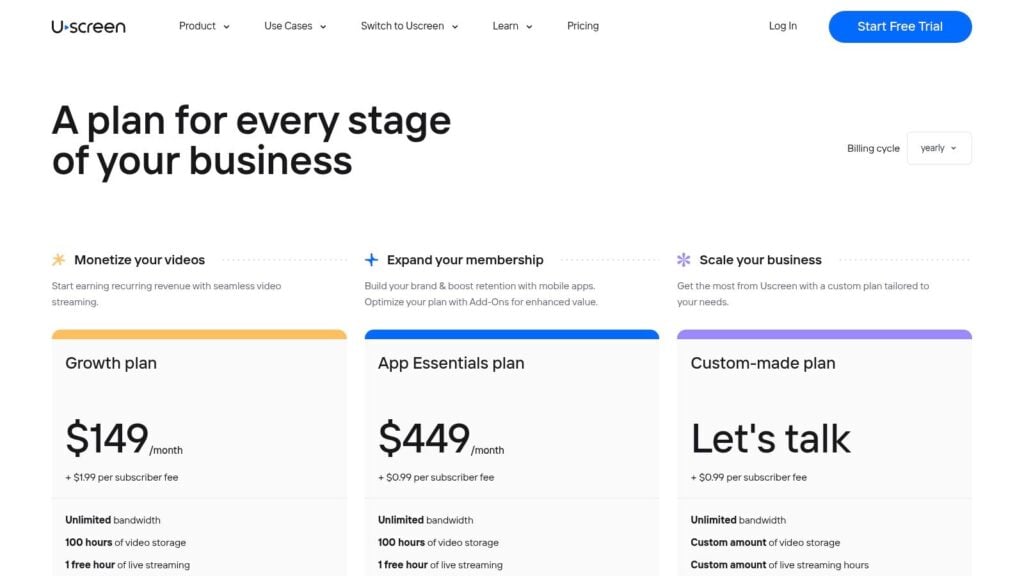
Uscreen gives you a robust catalog where you can offer subscriptions, one-time rentals, or bundled content packages. It also includes powerful community features, analytics, and marketing automations to help you grow your audience. The platform’s ability to handle the entire customer journey, from content delivery to billing and retention, makes it a powerhouse for serious course businesses aiming for scale.
Key Features & Pricing
Uscreen’s pricing is built for established businesses, starting with the Growth plan at $149/month plus $1.99 per subscriber. This includes your branded website and robust marketing tools. To get branded mobile and TV apps, you’ll need the Pro plan ($499/month + $0.99/subscriber) or a custom UscreenPlus plan. These higher tiers also unlock features like live streaming and advanced integrations.
Pros:
- Purpose-built for creating paid video membership sites and communities.
- Handles app distribution on eligible plans, getting you on iOS, Android, and TV.
- Strong catalog and audience retention tools to minimize churn.
- Great all-in-one solution for hosting, marketing, and monetization.
Cons:
- Pricing model includes a monthly platform fee plus a per-subscriber fee.
- Might be a heavier platform than needed for small or one-off courses.
Uscreen is the ideal choice for dedicated creators ready to build a premium, scalable video subscription service with a strong community focus.
Website: https://www.uscreen.tv/pricing
6. Spotlightr (formerly vooPlayer)
Spotlightr, which you might remember as vooPlayer, is a video hosting platform built with the specific needs of marketers and online course creators in mind. What makes it stand out is its powerful suite of security and engagement tools designed to protect and enhance educational content. I’ve found its HLS encryption and dynamic watermarking to be particularly effective for preventing unauthorized sharing, which is a major concern when selling premium courses.
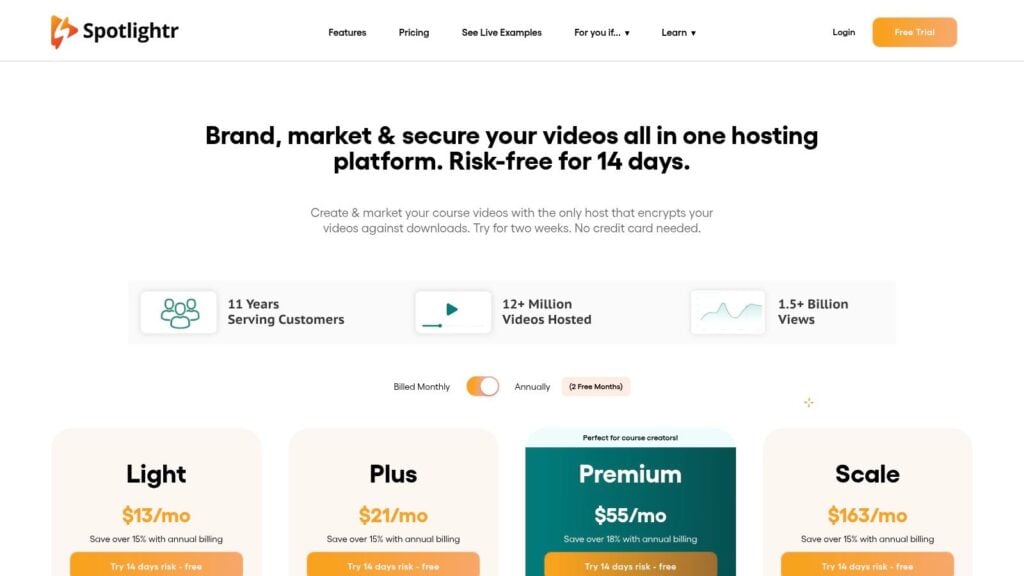
Beyond security, Spotlightr excels at making videos interactive. You can add in-video quizzes, calls to action, and even payment gates directly within the player. This means you can create gated content or lead generation forms without needing complex third party integrations. The detailed analytics, including viewer heatmaps and drop-off rates, give you actionable insights into how students are engaging with your lessons.
Key Features & Pricing
Spotlightr offers a few different pricing tiers. The Spark plan is $7/month (billed annually) and is great for getting started. For more advanced features like HLS encryption and in-video quizzes, you’ll want to look at the Polaris plan at $17/month. Their most popular plan for serious creators is Aurora at $47/month, which includes more bandwidth, storage, and advanced marketing integrations.
Pros:
- Strong security features like HLS encryption and domain restrictions.
- Built-in tools for monetization, quizzes, and lead capture.
- Detailed student-level analytics and engagement reporting.
- Competitive pricing specifically designed for course creators.
Cons:
- Bandwidth and storage caps are a key consideration when choosing a plan.
- The platform has a smaller ecosystem compared to giants like Vimeo.
- The interface can take a little time to master due to its many features.
Spotlightr is one of the best video hosting platforms for online courses if your top priorities are content security and interactive, data-driven learning experiences.
Website: https://spotlightr.com/pricing
7. Panopto
Panopto is a powerhouse in the educational and enterprise space, making it one of the most robust video hosting platforms for online courses offered by universities or large corporations. It’s built from the ground up for learning, with features like lecture capture, deep search capabilities that scan inside videos for spoken words, and seamless integrations with popular Learning Management Systems (LMS) like Canvas and Moodle. I see it as a complete video knowledge base, not just a hosting solution.

The platform shines with its powerful search and accessibility features. Students can search for a keyword and find the exact moment it’s mentioned in any video across the entire course library, which is a game changer for studying and review. Its strong focus on security, user permissions, and detailed analytics makes it a trusted choice for institutions that need to manage and deliver educational video content at a massive scale, securely.
Key Features & Pricing
Panopto’s pricing is tailored for educational institutions and businesses, so you won’t find simple monthly plans on their website. You’ll need to contact their sales team for a custom quote based on the number of users, usage hours, and specific features required. They offer Panopto Pro for individual departments and businesses, and Panopto Enterprise for institution-wide deployment with advanced features like on-premises deployment and deeper integrations.
Pros:
- Exceptional “inside video” search and automatic transcriptions.
- Deep integrations with major LMS platforms.
- Built for institutional scale with strong security and support.
- Excellent accessibility features, including captioning and screen reader support.
Cons:
- Pricing is quote-based and aimed at institutions, not solo creators.
- The feature set can be overkill and complex for a small business or individual.
- Less focused on marketing or sales features compared to other platforms.
Panopto is the undisputed choice for higher education or large corporate training programs needing an integrated, searchable, and secure video learning environment.
Website: https://www.panopto.com/
8. Thinkific
While not a standalone video host, Thinkific earns its spot because it’s an all-in-one platform that includes robust video hosting as part of its course creation suite. For creators who want a single, integrated solution to build, market, and sell their courses, this is a fantastic option. I find that this integrated approach simplifies the tech stack immensely, as you don’t need to subscribe to a separate video service and then figure out how to embed it securely. Everything just works together out of the box.
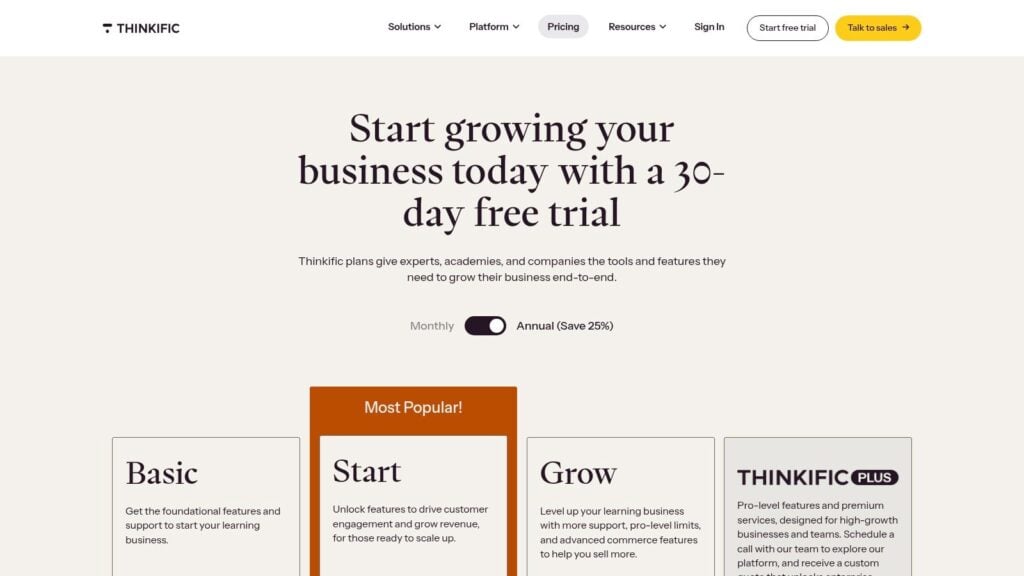
Thinkific handles the video delivery and security, allowing you to focus on creating content and engaging with students. It includes tools for quizzes, assignments, communities, and live lessons, making it a comprehensive learning environment. This makes it one of the better video hosting platforms for online courses if your goal is a turnkey business rather than just a place to store videos.
Key Features & Pricing
Thinkific offers a free plan to get started with one course. Paid plans begin with the Basic plan at $36/month (billed annually), offering unlimited courses and students. The Start plan at $74/month adds features like assignments and live sessions, while the Grow plan at $149/month provides API access and advanced customization. You can learn more about Thinkific and how it compares to other platforms.
Pros:
- Completely integrated solution with course building, payments, and hosting.
- Predictable and transparent pricing without video bandwidth limits.
- Excellent student experience with built-in community and engagement tools.
- Handles all the technical aspects of video security and delivery for you.
Cons:
- Video hosting cannot be used for anything outside the Thinkific platform.
- Not a fit if you only need a video host without the course-building tools.
- Advanced features like API access are reserved for higher-priced plans.
Thinkific is the ideal choice for course creators who want a single, powerful platform to manage their entire online education business from start to finish.
Website: https://www.thinkific.com/pricing
9. Teachable
Teachable takes a different approach by bundling everything you need into one package. It is an all-in-one platform for creating, marketing, and selling your entire online course, not just a video host. I find this integrated system is a huge advantage for creators who want to avoid the technical headache of piecing together different tools. You upload your videos directly to Teachable, and it handles the hosting, delivery, and even payment processing for you.
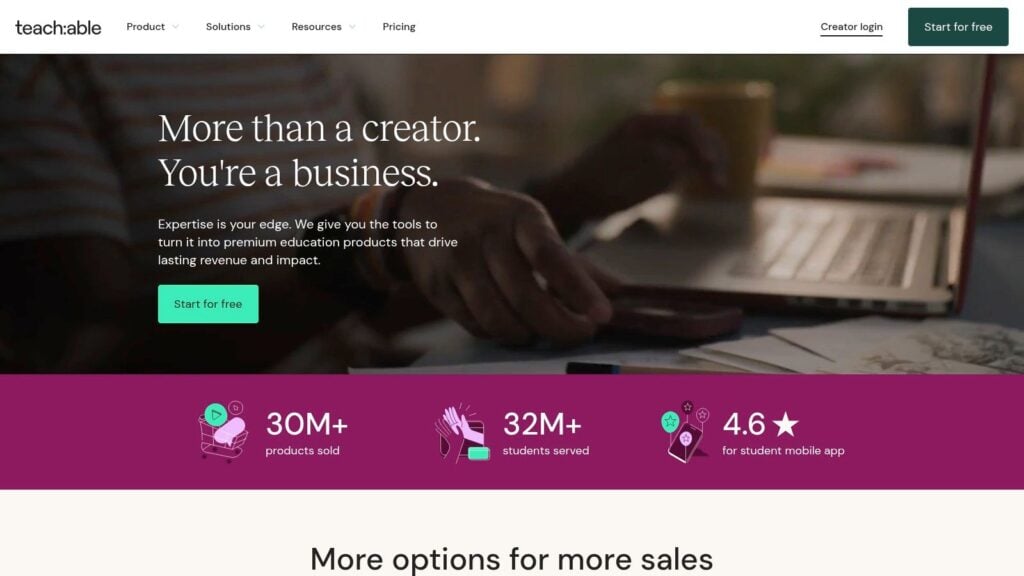
The platform is built around the course creation workflow, allowing you to add quizzes, drip content, and completion certificates alongside your video lessons. It also includes powerful sales tools like coupons, affiliate programs, and abandoned cart recovery. This makes it one of the most comprehensive video hosting platforms for online courses because the video is just one part of a larger ecosystem designed for monetization. If you want to explore more platforms like this, you can find a good list of Teachable alternatives that offer similar all-in-one features.
Key Features & Pricing
Teachable offers a free plan to get started. The Basic plan starts at $59/month with a 5% transaction fee. The Pro plan at $159/month drops the transaction fee to 0% and adds features like affiliate marketing and an unbranded website. The Pro+ plan at $249/month adds custom user roles. New pricing plans effective June 2025 will adjust these structures, so it’s wise to check their site for the latest details.
Pros:
- All-in-one solution for course creation, sales, and video hosting.
- Built-in marketing and sales tools simplify monetization.
- Handles complex sales tax (US, VAT, GST) automatically.
- Very user-friendly and great for solo creators starting out.
Cons:
- Transaction fees on the lower-tier plans can add up.
- Limits on the number of products and students on cheaper plans.
- Less flexibility compared to combining separate, specialized tools.
Teachable is the perfect choice for educators who want a single, streamlined platform to manage their entire course business from start to finish.
Website: https://teachable.com
10. Kajabi
Kajabi is an entire ecosystem for your online business, not just a video host. I often recommend it to creators who want everything under one roof: website, marketing funnels, email campaigns, a community, and of course, course hosting. The main appeal is that you don’t have to piece together different tools. The video hosting is seamlessly integrated into the course-building experience, which simplifies the entire process from upload to delivery.
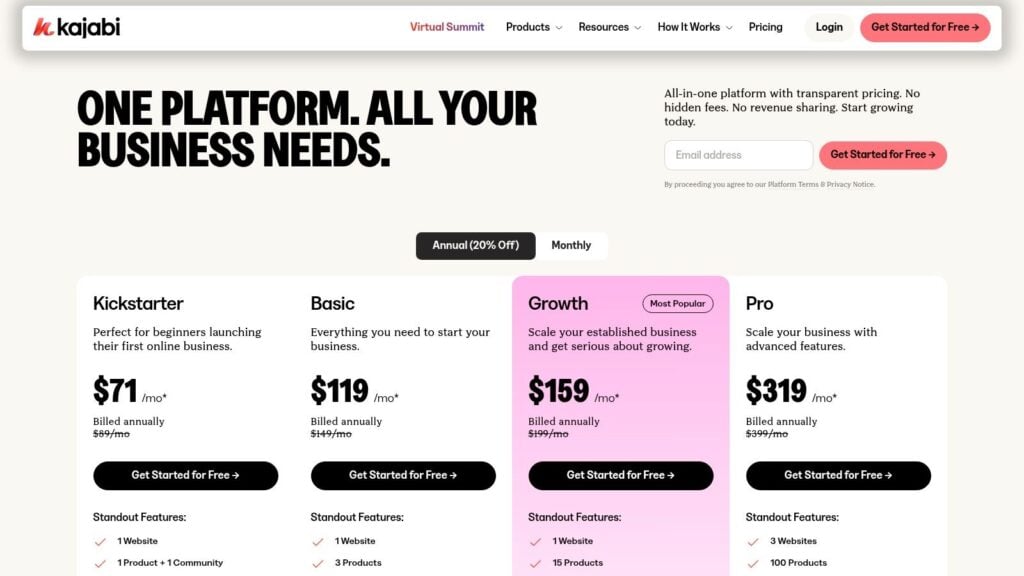
This all-in-one approach means your video content works hand-in-hand with powerful automations. For instance, you can automatically grant access to new course videos after a student completes a certain lesson or a payment is made. It’s one of the best integrated video hosting platforms for online courses because it’s built to support the entire student journey, not just video playback. The experience is smooth for students, too, with a clean interface and a dedicated mobile app.
Key Features & Pricing
Kajabi’s pricing reflects its all-in-one nature. The Basic plan starts at $149/month (or $119/month billed annually) and includes everything you need to launch your first course. As you grow, the Growth ($199/month) and Pro ($399/month) plans offer more products, pipelines, and contacts. A key benefit across all plans is zero transaction fees on your sales.
Pros:
- Single platform for your website, email, courses, and marketing.
- Powerful automations that connect video content to your business rules.
- Mature templates and a strong creator community with extensive support.
- No platform transaction fees, so you keep more of your revenue.
Cons:
- Higher price point compared to standalone video hosting services.
- Less granular video analytics and CDN control than dedicated hosts.
- Can be overkill if you only need a place to host videos.
Kajabi is the perfect solution for creators who want a powerful, unified platform to build and scale their entire online education business without technical headaches.
Website: https://kajabi.com/pricing
11. LearnWorlds
LearnWorlds is much more than just a place to host your videos. It is a full-fledged learning management system (LMS) with some of the best interactive video tools I’ve seen. Instead of just offering video playback, LearnWorlds lets you build pedagogical elements directly into your lessons. You can add quizzes, buttons, pointers, and even watermarks inside the video player itself, transforming passive viewing into an active learning experience.
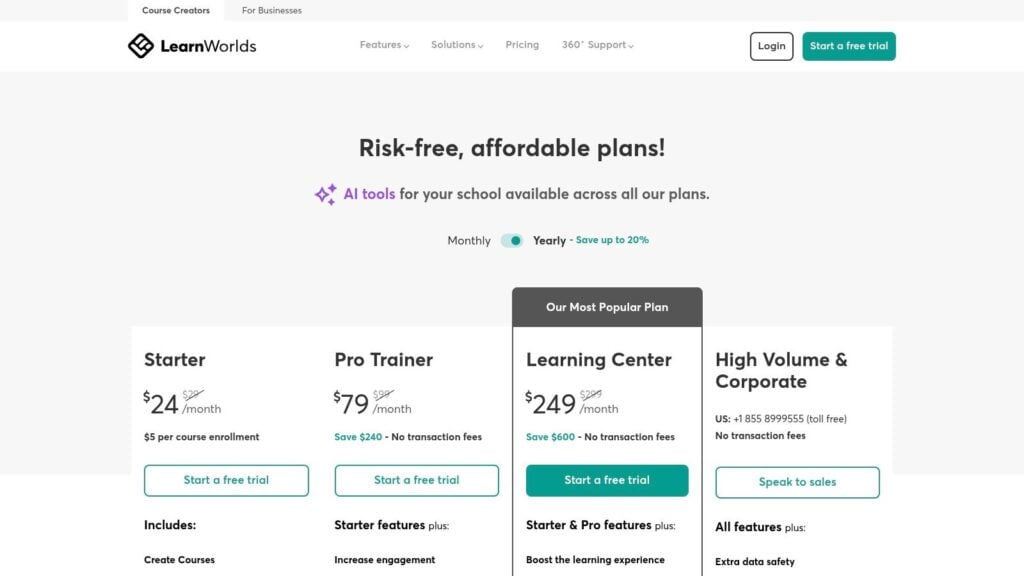
This all-in-one approach is what makes it stand out among other video hosting platforms for online courses. It supports SCORM and HTML5 content, which is a big deal for corporate trainers or those with existing instructional design materials. It also handles the business side of things well, with powerful payment options, multi-instructor support, and features for globalization, like multi-language site support. If you want a platform that deeply integrates learning tools with video hosting, this is a top contender.
Key Features & Pricing
LearnWorlds’ plans start with the Starter tier at $24/month (billed annually), but it includes a $5 fee per course sale. To eliminate transaction fees and unlock more features, you’ll want to look at the Pro Trainer ($79/month) or Learning Center ($249/month) plans. The higher tiers add advanced features like subscriptions, installments, and full white-label options.
Pros:
- Outstanding interactive video tools enhance student engagement.
- All-in-one platform handles hosting, course creation, and sales.
- Great for multi-instructor academies and complex course offerings.
- Transparent pricing with no platform transaction fees on higher plans.
Cons:
- The Starter plan’s $5 per enrollment fee can be costly for new creators.
- The user interface can feel more complex than simpler hosting tools.
- Primarily a course platform, so it might be overkill if you just need video hosting.
LearnWorlds is the ideal choice for serious educators who want to build an entire school, not just host videos. For more details on how it stacks up against competitors, you can learn more about LearnWorlds’ features.
Website: https://www.learnworlds.com/pricing
12. Bunny.net Stream
Bunny.net Stream is a fantastic choice for the more technically-inclined course creator who wants incredible performance at a very low cost. It’s a developer-friendly platform that operates on a pay-as-you-go model, which I find refreshing. You get a powerful global CDN, free video transcoding, and a customizable player, all while only paying for the storage and bandwidth you actually use. This makes it one of the most cost-effective video hosting platforms for online courses if you’re comfortable with a bit of setup.
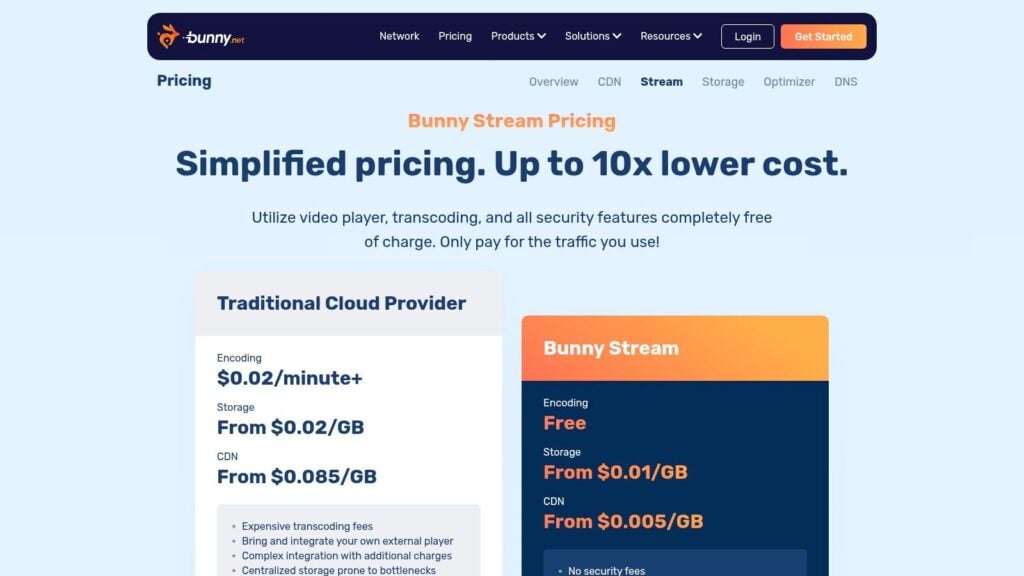
This platform isn’t an all-in-one solution like Kajabi. Instead, it’s designed to be integrated into your existing website, like a WordPress site running an LMS plugin. The control you get is granular. You can enable or disable content delivery in specific geographic regions to manage costs and even add DRM for enhanced security. It’s a powerful backend for your video content, giving you an enterprise-grade delivery network without the enterprise price tag.
Key Features & Pricing
Bunny.net Stream’s pricing is entirely usage-based. You pay for storage and CDN bandwidth, with different rates for various global regions. Storage is $0.01/GB per month, and CDN traffic starts as low as $0.005/GB. Features like DRM and transcription are available as paid add-ons. There are no monthly subscription fees, making it highly scalable as your course grows.
Pros:
- Extremely cost-effective pay-as-you-go pricing model.
- High-performance global CDN ensures fast video delivery.
- Flexible and integrates well with WordPress, LMS plugins, and custom sites.
- Provides fine-grained control over security and regional delivery.
Cons:
- Requires more technical setup than all-in-one platforms.
- Lacks built-in course creation tools like quizzes or checkouts.
- The interface is more functional than beginner-friendly.
Bunny.net Stream is ideal for course creators who have an existing website and want a fast, affordable, and scalable video hosting engine running in the background.
Website: https://bunny.net/pricing/stream/
Video Hosting Platforms Feature Comparison
| Platform | Core Features | User Experience & Quality Metrics | Target Audience | Price Points & Notes |
|---|---|---|---|---|
| Vimeo | Customizable player, privacy controls, OTT | Ad-free playback, strong integrations | Creators, SMBs, enterprises | Starter to Enterprise; limited free tier |
| Wistia | Custom player, marketing integrations, webinars | Excellent analytics, clean brand embeds | Marketers, educators | Tiered pricing including free plan |
| SproutVideo | White-label, viewer login, live streaming | Strong security, US-based support | Course creators, businesses | Fixed quotas; extra fees for overages |
| Dacast | Live/VOD, paywalls, DRM, multi-CDN delivery | Event-focused, good monetization options | Broadcasters, educators | Quota-based plans; broadcaster-oriented |
| Uscreen | Subscriptions, rentals, mobile/TV apps | Strong audience retention, app distribution | Subscription academies, communities | Monthly + per-subscriber fees |
| Spotlightr | HLS encryption, quizzes, LMS integrations | Built-in monetization, analytics, anti-download | Course creators | Tiered plans with bandwidth caps |
| Panopto | Lecture capture, transcripts, LMS integration | Institutional scale, accessibility features | Academia, corporate training | Pricing via sales; enterprise focus |
| Thinkific | Course hosting, payments, community features | Strong checkout experience, simple setup | SMBs, solo creators | Transparent SMB pricing |
| Teachable | Courses, memberships, drip content, marketing | Easy to use, sales tax handling | Solo creators, small businesses | Starter with 7.5% fees; refreshed pricing |
| Kajabi | Courses, email marketing, funnels, CRM | Mature templates, unified platform | Creators wanting full suite | Higher price point; no transaction fees |
| LearnWorlds | Interactive video, SCORM support, multi-instructor | Advanced pedagogy tools, multi-product support | Academies, multi-instructor | No transaction fees; enrollment fees apply |
| Bunny.net Stream | Low-cost streaming, pay-as-you-go storage | Developer-friendly, global CDN | Developers, WordPress/LMS users | Usage-based billing; technical setup needed |
So, What’s the Best Video Platform for Your Course?
We’ve covered a lot of ground, from dedicated video hosting giants like Vimeo and Wistia to the all-in-one platforms like Kajabi and Thinkific. The big takeaway? There is no single “best” video hosting platform for online courses. Instead, there’s a “best fit” for your specific business, your budget, and your students.
The sheer number of choices can feel overwhelming, but this is actually great news. It means the market has matured to offer specialized solutions for every type of course creator, from the solo entrepreneur launching their first mini-course to a large corporation building a comprehensive training library.
Key Insights to Take With You
Let’s distill our deep dive into a few core principles. The most crucial decision point often comes down to a fundamental choice: do you want a dedicated video host or an all-in-one course platform?
Dedicated Hosts (like Wistia, Vimeo, SproutVideo): These are your best bet if you prioritize granular control, advanced analytics, and marketing integrations. If you already have a website or learning management system (LMS) you love, a dedicated host gives you the power and flexibility to embed top-tier video experiences anywhere you need them. They are specialists, and their feature sets reflect that focus.
All-in-One Platforms (like Kajabi, Teachable, Uscreen): If your goal is simplicity and a seamless, integrated student experience, these platforms are incredible. They handle everything: video hosting, payment processing, community features, and course structure. The video hosting might not have the deep analytical power of a Wistia, but it’s built to work perfectly within its own ecosystem, saving you time and technical headaches.
The lines are blurring, too. Platforms like Uscreen are a hybrid, offering powerful video-on-demand features that feel like a dedicated host but within a complete monetization framework. And technical solutions like Bunny.net Stream offer an affordable, developer-friendly alternative for those comfortable with a more hands-on approach.
Your Action Plan for Choosing the Right Platform
Feeling stuck? Here’s a simple framework to guide your decision. Grab a notebook and answer these questions honestly.
What’s My True Budget? Don’t just look at the monthly price. Factor in potential bandwidth overage costs (especially with platforms like Dacast or Bunny.net) and transaction fees on all-in-one platforms. Create a realistic budget for your first year.
How Important Are Video Analytics? Do you just need to see view counts, or do you need heatmaps, A/B testing, and lead capture forms inside your videos? Your answer will quickly point you toward or away from marketing-focused hosts like Wistia.
What’s My Technical Comfort Level? Be real with yourself. Are you comfortable pasting embed codes and working with plugins? If so, a dedicated host is a great option. If the thought of connecting different systems makes you nervous, an all-in-one platform will be your best friend.
What Is My Primary Goal? Is it to sell individual courses? Build a subscription-based community like a “Netflix for your niche”? Or provide corporate training? Uscreen is built for the subscription model, while Panopto excels in the corporate and educational space. Align the platform’s purpose with your own.
Once you have these answers, revisit the list. Three or four options will likely stand out as the clear front-runners. From there, your final step is to sign up for free trials. There is no substitute for getting your hands on the software. Upload a test video, play with the settings, and see how it feels. The right choice will not only look good on paper but will also feel intuitive to you.
Choosing from the many video hosting platforms for online courses is a foundational decision for your business. It impacts your students’ learning experience, your marketing capabilities, and your day-to-day workflow. Take your time, do the research, and trust your gut. Your future students (and your future self) will thank you for it.






